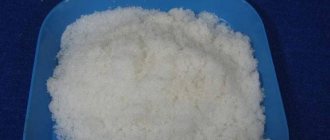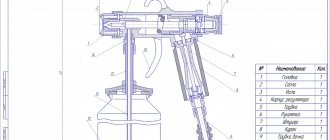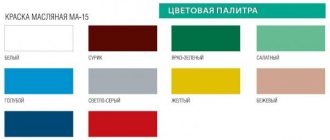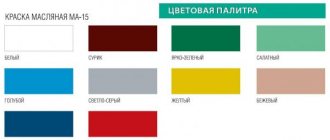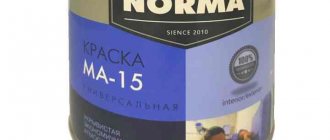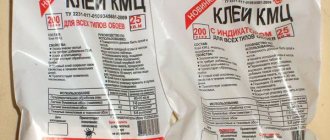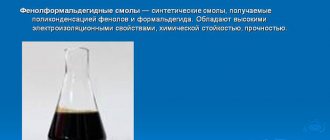- Characteristics
- Areas of application
- Operating rules
- Anti-rust application
- Application for metal
Often metal and products made from it are subject to a characteristic “disease”, which manifests itself in the form of a red coating that corrodes the metal. We're talking about rust. Its formation occurs due to the effect of carbon dioxide, oxygen and water on the surface of a metal product. Of course, in order to extend the life of a metal product, it is necessary to begin the fight against corrosion as soon as possible. Treatment with phosphoric acid can help with this.
Properties of phosphoric acid
Physical properties
Phosphoric acid is the most stable phosphoric acid at room temperature. In addition to orthophosphoric acid H3PO4, there is metaphosphoric acid HPO3, pyrophosphoric acid H4P2O7, triphosphoric acid H3P3O9 and tetraphosphoric acid H4P4O12. The last three are much stronger than orthophosphoric acid (K1 = 7 ⋅ \cdot ⋅ 10-3).
| Property | Description |
| Appearance | Colorless liquid in aqueous solution, in its pure form - hygroscopic crystals |
| Molar mass, g/mol | 98,0 |
| Density at 20°C, g/cm3 | 1,83 |
| Melting point, °C | +42,35 |
| Boiling point, °C | 213 (dec.) |
Chemical properties
In aqueous solutions, phosphoric acid dissociates into ions :
H3PO4 ⇄ \rightleftarrows ⇄ H+ + H2PO4-, ⇄ \rightleftarrows ⇄ 2H+ + HPO42- ⇄ \rightleftarrows ⇄ 3H+ + PO43-.
Dissociation constants
K1 = 7.1·10-3,
K2 = 6.2·10-8,
K3 = 5.0·10-13.
At room temperature, phosphoric acid reacts only with active metals, oxides and hydroxides:
6Li + 2H3PO4 = 2Li3PO4 + 3H2↑,
3CaO + 2H3PO4 = Ca3(PO4)2 + 3H2O,
3KOH + H3PO4 = K3PO4 + 3H2O.
When heated , it is more active:
3Zn + 2H3PO4 = 2Zn3(PO4)2 ↓+ 3H2↑,
Fe2O3 + 2H3PO4 = 2FePO4↓+ 3H2O.
Phosphoric acid decomposes when heated:
4H3PO4 = 2H4P2O7 + 2H2O.
Phosphoric acid reacts with perchloric acid to form phosphoryl salts:
H3PO4 + HClO4= P(OH)4ClO4.
Therefore, phosphoric acid can be considered an amphoteric phosphorus (V) hydroxide with a predominance of acidic properties.
Application
Phosphoric acid is used in many areas, from industry to dental treatment. The product is used by craftsmen as a flux when soldering, to clean the metal surface from rust. Liquid is used:
- for scientific research in molecular biology;
- as a catalyst for organic synthesis processes;
- for creating anti-corrosion coatings on metals;
- in the production of fire-resistant impregnations for wood.
The substance is used:
- in the oil industry;
- in the manufacture of matches;
- for film production;
- for the purpose of protection against corrosion;
- to clarify sucrose;
- in the manufacture of medicines;
- in refrigeration units as a binder in freon;
- during mechanical processing for polishing and cleaning metals;
- in the textile industry in the production of fabrics with fire retardant impregnation;
- as a component in the production of chemical reagents;
- in veterinary medicine for the treatment of urolithiasis in minks;
- as a component for metal primer.
In the food industry
The use of phosphoric acid in food production has become widespread. It is registered in the register of food additives under code E338. When consumed in acceptable quantities, the substance is considered safe. The following properties of the drug are useful:
- preventing rancidity;
- acidity regulation;
- shelf life extension;
- preservation of taste characteristics;
- enhancing the effect of antioxidants.
Phosphoric acid as an acidifier, leavening agent, and antioxidant is used in the bakery, meat, and dairy industries. Used in the production of confectionery and sugar. The substance gives products a sour, bitter taste. Additive E338 is included in:
- processed cheeses;
- muffins;
- carbonated drinks - Pepsi-Cola, Sprite;
- sausages;
- buns;
- milk;
- baby food;
- marmalade;
- cakes
Research has shown that overconsumption of products containing phosphorus compounds, especially carbonated drinks, can lead to health problems. It is possible:
- leaching of calcium from the body, which can trigger the formation of osteoporosis;
- violation of the acid-base balance - the additive can increase its acidity;
- the appearance of gastrointestinal diseases;
- exacerbation of gastritis;
- destruction of tooth enamel;
- development of caries;
- the appearance of vomiting.
In the non-food industry
The use of phosphoric acid can be observed in many areas of production. This is often due to the chemical properties of the product. The drug is used for the manufacture of:
- combined, phosphorus mineral fertilizers;
- activated carbon;
- phosphorus salts of sodium, ammonium, manganese;
- fire retardant paints;
- glass, ceramics;
- synthetic detergents;
- fire-resistant binding components;
- non-flammable phosphate foam;
- hydraulic fluids for the aviation industry.
- Causes of shortness of breath in humans. Shortness of breath - causes and treatment
- Antifungal drugs for feet
- Medical Foley catheter
In medicine
Dentists use orthophosphorus composition to treat the inner surface of the crown. This helps improve its adhesion to the tooth during prosthetics. The substance is used by pharmacists to prepare medicines and dental cement. In medicine, the use of orthophosphorus compounds is associated with the ability to etch tooth enamel. This is necessary when using adhesive materials of the second or third generation for filling. Important points - after etching the surface it is necessary to:
- Rinse;
- dry.
Receipt
Laboratory methods of obtaining
Phosphoric acid is obtained in laboratory conditions from (V) oxide
P2O5 + 3H2O = 2H3PO4.
The reaction proceeds violently, so it is better to obtain it in this way in industry.
Phosphoric acid can be obtained from phosphates by the action of hydrochloric or sulfuric acid:
Na3PO4 + 3HCI = 3NaCI + H3PO4.
phosphorus (V) can be hydrolyzed
2PCl5+ 8H2O = 2H3PO4 + 10HCl.
Receipt in industry
In industry, the purest phosphoric acid is obtained thermally, for which phosphorus is burned:
4P +5O2 = 2P2O5.
Phosphoric anhydride reacts with water too violently, so phosphoric anhydride is mixed with phosphoric acid heated to 200°C in a concentration of 50-60%. The resulting acid is diluted and partially restarted in the process.
There is an extraction method for obtaining phosphoric acid directly from ores, for example, from apatite:
Ca5(PO4)3F + 5H2SO4 + n H3PO4 + 3H2O = (n+3) H3PO4+ 5CaSO4 H2O + HF.
History of discovery
The discovery of phosphoric acid occurred in the 17th century in several independent laboratories.
The first mention of the discovery of phosphorus dates back to the German scientist Henning Brandt. A bankrupt entrepreneur, carried away by alchemical experiments in search of the “philosopher’s stone,” subjected the products of human activity to careful study. By evaporating the urine and heating the remaining sediment, Brandt obtained a white substance. Further experiments with this substance, which involved heating without oxygen, helped to isolate a fusible substance with unpleasant odors and vapors that glow in the dark. The first name of this substance had a very mystical character. “Cold fire,” that’s what Hening Brand called his discovery.
In the laboratory of the Anglo-Irish chemist Robert Boyle, known in scientific circles for preferring experience rather than speculation, phosphorus was isolated in 1680 using experiments with indicators. Boyle (with Kraft's advice) after conducting a series of experiments with liquids, blood, urine, hair and bones, put the production of phosphorus on a commercial basis.
The production of phosphorus in the 17th century was very successful commercially, due to its connection with alchemical searches, but in the 18th century, due to the discovery of another method of production (by the scientist Marggrave Andreas Sigismund) and its comprehensive disclosure, it ceased to have commercial appeal.
Products for removing corrosion from metal
Corrosive processes affecting metal worsen its characteristics, and if no measures are taken, they contribute to destruction. You can cope with the problem at home using various acids.
Lemon
Using citric acid to eliminate corrosion can help with minor metal damage.
Application:
- Dissolve citric acid in water in a 1:1 ratio.
- Apply to the corroded area. You can soak a rag in the liquid and apply it to the damaged metal.
- Leave for several hours, making sure that the metal surface remains moisturized.
- Remove loose rust with a brush or scraper.
- Rinse the area of metal exposed to the acid with water.
The best result in removing rust can be achieved by mixing it in equal proportions with vinegar. More information about the use of citric acid against rust can be found here.
Sulfuric
Sulfuric acid will help solve the corrosion problem quickly and effectively. An aqueous solution is prepared for use. Its density should be no more than 1.15 g/cm³, since a higher concentration can damage the metal.
Experts advise combining acid with an inhibitor. The solution should contain sulfuric acid (5%), 1 liter of water and methenamine (500 mg).
The procedure for exposure involves dipping the metal into the solution for half an hour. If the object is large, then surface treatment with a brush is used. At the end of the exposure, it is recommended to treat the metal with a weak solution of ammonia to neutralize it.
Orthophosphoric
Phosphoric acid is one of the commonly used components of ready-made rust removers and converters. It can be used in the form of a solution.
Work order:
- clean the metal surface by mechanically removing the top layer of rust;
- prepare an acid solution with a concentration of 15-20%;
- treat the surface.
As a result of application, a film is formed on the metal surface, which can protect the surface from further corrosion. And it can serve as a primer before painting. More information about the use of phosphoric acid in the fight against rust can be found here.
Sorrel
The use of oxalic acid requires the use of a respirator and glasses.
Algorithm of actions:
- The area of metal that requires rust removal must be washed with soapy water or dishwashing detergent.
- Rinse with water.
- Wipe dry.
- Pour 0.3 liters of water into a separate container.
- Add 6 tsp to water. acids.
- Place the item in the container.
- Leave for half an hour.
- Clean off plaque.
- Rinse the item with hot water.
- Wipe with a napkin.
If the item cannot be cleaned by immersion in a container, the damaged area should be moistened with the prepared solution and left for 30-40 minutes. After this, clean off the deposits and wash the metal.
Vinegar
Table vinegar can be used to remove rust due to the acetic acid it contains.
The procedure for carrying out work using the immersion method:
- prepare a container into which the rusty metal object can be immersed entirely;
- fill the container with vinegar;
- place a metal product in the solution;
- stand for several hours (at least 2);
- get an item;
- using a wire brush, remove rust;
- wash the item.
If the items are very small, it is possible, after soaking the items in vinegar, to use aluminum foil to remove plaque.
The proposed method is convenient for processing small metal objects:
- coins;
- bolts;
- nuts;
- keys, etc.
If you need to process a large metal product (for example, a shovel, fittings, etc.), you will have to use this method:
- Soak a rag generously in vinegar.
- Cover the area affected by corrosion with a rag soaked in vinegar.
- Leave for several hours (at least 2), periodically moistening the rag with vinegar.
- Clean off rust.
- Wash off any remaining vinegar from the metal surface.
Useful information about the method of removing rust using vinegar can be found in this article.
Anti-rust application
A rust converter based on phosphoric acid creates a protective layer on the surface that protects against corrosion during further use. The peculiarity of using the compound is that it is safe for metal when applied. There are several ways to remove rust with phosphoric acid, depending on the size of the damage:
- etching with immersion in a bath or other container;
- repeated application of the composition to the metal with a spray gun or roller;
- covering the surface with pre-treated mechanical cleaning.
The orthophosphorus compound converts rust into iron phosphates. The composition can be used for washing and cleaning:
- rolled metal products;
- wells;
- pipeline surfaces;
- steam generators;
- water supply, heating systems;
- coils;
- boilers;
- water heaters;
- heat exchangers;
- boilers;
- machine parts and mechanisms.
Expert advice
You need to clean areas of rust very carefully so that no holes appear and the metal does not become too thin. It is not recommended to use discs with very large abrasive particles during work, as instead of removing rust, they can cause more harm than good.
Before starting all repair work to remove rust, you must remember that this product is very powerful and strong. After all, it can remove not only the rust itself, but also the decorative coating: chrome, zinc. Therefore, it is necessary to process car parts very carefully and carefully so that you do not have to spend money on new spare parts in the future.
If all work to remove rust using phosphoric acid was carried out in accordance with all standards, then the resulting surface will be durable and reliable. And although the use of converters is considered the most popular method for body work, we should not forget about other options known to craftsmen.
A little converter is applied to a surface cleaned of a thick layer of rust and left for a couple of minutes or hours, depending on the concentration of the solution, and then further repair work begins.
Previous MaterialsUsing camouflage vinyl film for a car Next MaterialsThe best anti-corrosion agent for a car today: rating of anti-corrosion body treatment products
Ecology and safety
Using the extraction method, which is the least energy-intensive, up to 95% of the total amount of acid is obtained, and the remaining 5% comes from the thermal method. The main producer and consumer of extraction H3PO4 is the USA (about 90% of global volumes), followed by Russia and Morocco. Dumps of contaminated calcium sulfate formed during the extraction method need to be disposed of.
Today they are dumped on land, flooded in reservoirs, and only a small part is used as raw material for processing. The reduction in production in the 80s of the last century was caused by the abandonment of phosphorus-containing solvents and mineral fertilizers that pollute groundwater.
Orthophosphoric acid has no specific effect, has weak systemic toxicity and, in terms of the degree of impact on the human body, belongs to the second hazard class according to GOST 12.1.005. When the concentration increases, its vapor causes changes in the mucous membranes and crumbling of teeth, as well as skin inflammation.
Contact has an irritating effect at a solution concentration of up to 10%, and above 25% it is corrosive and burns.
Working with the drug requires the use of personal protective equipment (respirator, rubber gloves, special glasses) and compliance with personal hygiene rules. Ingestion of large quantities causes nausea, diarrhea and vomiting. To eliminate the consequences, the skin and eyes are washed with warm water or saline and fluid losses are replenished intravenously.
Structure
The compound H3PO4 has a total of 32 valence electrons. Since phosphorus is the least electronegative, it is placed in the center. Hydrogen atoms attach to the outside of oxygen atoms, forming he-groups.
In this structure, each atom has a full outer shell: phosphorus and oxygen atoms have eight valence electrons, and hydrogen atoms have two valence electrons around them.
Phosphorus may have an extended octet (more than eight valence electrons), so it receives a +1 formal charge, while oxygen (the one not attached to a hydrogen atom) receives a -1 formal charge. By forming a double bond, phosphorus and oxygen lose their charges.
There are still 32 valence electrons in the structure, and each atom has a formal charge of zero. So this is the most likely or probable Lewis structure for H3PO4.
The compound contains 3 OH single bonds, 3 PO single bonds and 1 P=O double bond. Each single bond is a sigma bond and the double bond consists of a sigma bond and a pi bond.
Phosphoric acid: spherical model and dimensions of the structural formula
The molecular geometry of PO(OH)3 is tetrahedral and the crystal structure is monoclinic. And since the distribution of charges on the central atoms is asymmetrical, the molecule is considered polar.
Recent advances in nanotechnology, including near-edge X-ray absorption techniques and high-angle X-ray scattering techniques, have allowed scientists to accurately determine the structure of phosphoric acid. The P=O bond distance in the structure is close to 152 picometers, and the P=OO distances were refined to 309 picometers, with a bond angle close to tetrahedral.
Content
- 1 Physical properties
- 2 Chemical properties
- 3 Preparation 3.1 Thermal method
- 3.2 Extraction method
- 3.3 Concentration and purification
- 3.4 Economic and environmental aspects
- 4.1 Aviation industry
Price
Phosphoric acid can be purchased in pharmacies, hardware stores, and ordered through Internet sites. For industrial purposes, they are purchased in bulk at discounts. The average cost for Moscow in rubles is:
| Quantity, liter | Average price, rub. | |
| Food thermal | 1 | 400 |
| Technical 85% | 0,8 | 380 |
| 1600 | 13500 | |
| Soldering flux | 0,01 | 180 |
| 0,003 | 40 | |
| Food additive E388 | 1 | 85 |
How does it work
The process is simple. You buy a converter; it usually comes in spray cans. Next, it is sprayed onto the site of the outbreak, then it is advisable for us to leave this place for about half an hour - an hour.
The product does not remove rust at all, if I may put it roughly, it freezes it and prevents it from spreading further. An iron phosphate film forms on the affected surface, which is a protective element. The work period is approximately one to two years, then it is advisable to repeat the procedure.
I would like to note from personal experience that my uncle is a minibus taxi driver and works on his minibus almost every season before winter. And you know, it really rots less when compared with untreated neighboring cars along the route.
But we are wondering whether it is possible to produce it with our own hands, what is the approximate composition. I’ll say right away that there are two compositions, the one that is used in production, and the one that is made at home.
Transportation rules
There are special GOSTs that stipulate the rules for transporting phosphoric acid, which is classified as dangerous goods. The substance can be delivered by any type of transport. The chemically active liquid is transported in tightly closed:
- steel tank trucks;
- bottles made of polyethylene, glass;
- plastic cubes;
- barrels;
- cans;
- rubberized railway tanks.
